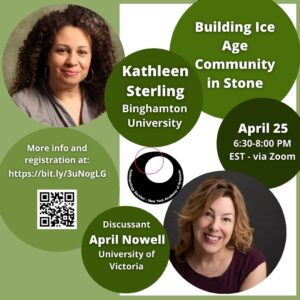NYAS Lecture 4/25: Building Ice Age Community In Stone

General
Right or wrong, Westerners use the hunting and gathering peoples of the Ice Age as models of what is natural for human behavior. These “common-sense” reconstructions often have a very narrow survival focus that emphasizes neoliberal ideas of competition, rationality, and efficiency as seen through a modern lens. This only serves to recreate present ideologies in the past, and in so doing, justify them. The limits of archaeological preservation, especially the further back we look in the past, compound the impression of “lack” in their lives. The two popular names for the late Pleistocene, the “Ice Age” and the “Stone Age” further contribute to the feeling of lack: a lack of warmth, and a lack of materials. The result is a grim image of the lives of human ancestors: nasty, brutish, and short. These notions are in contrast to some of the best-known material production from this very long time period: the painted and engraved caves and rockshelters; the figurines, flutes, and bas-relief objects; as well as the fact that this lifeway persisted for tens of thousands of years.
Stone, the most abundant material we can recover archaeologically, can create a different picture. Rather than see stone as a lack of better options, we can look at the ways in which they used stone to fulfill their wants and needs, express their worldviews, and mediate their relationships with the world and other people. We see an example of this at the site of Peyre Blanque, located in what is now the French central Pyrenees and occupied nearly 20,000 years ago. In a landscape filled with caves and rockshelters, people carried blocks of stone uphill to create a structure that was likely used as shelter. They created tools out of other blocks of stone they carried from 300 meters away, from 200 km away, and points in between. They were likely connected to people who painted caves and rockshelters, or did that themselves, and carried pieces of important places with them in the form of stone. If we insist on looking to the Ice Age for lessons about humanity, it is not difficult to find examples of community and connection through stone, and community was how people not just survived, but thrived in the deep past.
Featured Speaker
Kathleen Sterling’s research is centered in the French Pyrenees, where she is currently co-director of Peyre Blanque, an open-air late Paleolithic site. This project grew out of a long-term pedestrian survey project that has collected thousands of lithic objects spanning the Paleolithic. Her interests include lithic technology, learning and identity, communities of practice, Paleolithic visual imagery, hunting and gathering groups, gender and feminist science, Black feminist theory, landscape archaeology, and the sociopolitics of archaeology. The themes of her work are concerned with dispelling myths about human ancestors as violent, primitive, and limited. She is also concerned with equal opportunity in anthropology and science in general, particularly in the ways in which this has an impact on knowledge production.
Discussant
April Nowell is a Paleolithic archaeologist and Professor of Anthropology at the University of Victoria, Canada. She directs an international team of scientists in the study of Lower and Middle Paleolithic sites in Jordan and collaborates with colleagues on the study of Paleolithic rock art in Australia and France and on ostrich eggshell beads in South Africa. She is known for her publications on cognitive archaeology, Paleolithic art, the archaeology of children and the relationship between science, pop culture and the media. She is the author of the new book Growing Up in the Ice Age: Fossil and Archaeological Evidence of the Lived lives of Plio-Pleistocene Children.